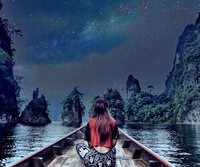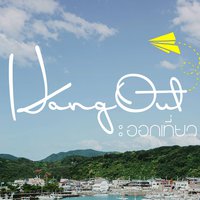For this trip, I'm travelling from my home surrounded by skyscrapers to " Baan Nai Wong" a village embraced by mountains.

The slogan of the village says "Green forest, rafting trip, enjoy the beauty of the mountains, and tracking the wars. I plan to go for the first two activities and continue my trip to Chumphon Province.
And come back to Ranong for the flight back home. It will be 4 days and 3 nights without any plans. I make it in high-tech way by posting in Facebook asking anyone helping me to organize the trip.
One of my close friends writes me to recommend a place I can't miss which is La-Oun District. He also organizes everything for me.
On that day someone is going to the town. So only thing I need to do is to get myself to the town after the plane's landing. Then, I will be taken to the destination afterward. Lucky me!
At ten to six, the sun is shining as it usually is in September. The earth is slowly welcoming the sun.
Two round-trip flight tickets are in my hand as well as the baggage is well packed.
I just bring only the needed stuff with me as I must get to the airport by public transport. I get on a taxi at the entrance to the side street, continue with the sky train to Mo chit Station, and I finally get on the airport bus A1 to Don Mueang International Airport. Here we go.
I start my journey again, leaving my home that is surrounding with boring buildings for a couple days.

Nok Air has two flights to Ranong Province, in the morning and in the evening. The flight leaves BKK at 9.20 and 16.55 and leaves Ranong at 10.05 and 18.45. It takes about 1 hour and 25 minutes on the plane. I'll let you guess which time I go. The answer is I take the flight in the morning to go there and go back by the evening flight. So I can spend a lot of time enjoying my journey.
I go there with one of my friends in Facebook.
Although traveling alone is something real challenging and exciting as you step out of your comfort zone, a journey with a friend has several advantages that you shouldn't overlook.

I have a chance to go with a turboprop again. The brand new turboprop aircrafts are Q400 NextGen, imported from Canada by Nok Air last year. There are six of them for domestic flights.
The propellers themselves seem resound, but actually the engines work pretty quietly. Q is stand for Quiet. It is 15 DB quieter than the international standard ICAO Chapter 4. It's really quiet. I confirm!

We arrive at the Ranong Airport at 11 sharp. A man comes to ask me if I want to go to the town with his van, 200 baht per person. I think it's quite expensive at this price for 20 km. to town, so I decide to be a hitchhiker.
I look around for someone who can give us a ride and ask him for a favor with a big smile. Of course he let us go with him. Great! I heard the Southern people are kind. This' s totally true. On the other hand, the man from the van may not quite happy with that.

The weather is really nice and the sky is much clearer than I expected. Since everyone knows Ranong is the wettest of all the province in Thailand. But not so long after that, the clear blue sky with no clues of raining suddenly changes. It starts to rain.
The raindrops are getting bigger. The driver stops the car to let us get off at a bus stop until it stops raining as it is only 5-6 km. away from the town.

We have been waiting almost an hour and getting very hungry. Luckily, there is a woman selling food, like some sticky rice with sun-dried pork, coming to us. So, we have something to eat for that meal.
We finally call the one who is going to pick us up to come here instead. A few minutes later, he comes. He is called "Somchai (Khun Nui) Thitkrathok" (the one in green) and his friend (I totally forget his name).
He drives a pickup from Baan Nai Wong, La-Oun District, to pick us up after they finish their affairs. This is another good thing we have for this trip.
We now start our journey to La-Oun. We have eaten something on the way but it doesn't seem enough for us. Our local guides are quite kind, so they take us to a restaurant called "Pa-Saaw (Young Aunt)" which is in the town. Our chef is a lovely young Burma lady. We order two bowls of egg rice noodles.

The top one is the young Burma lady and the other is Aunt Saaw. Don't get confused.
After that, we take a short walk to some famous tourist spots in the town. They can't be missed by tourists.
Raksavarin Public Park
Municipality, Ranong Province

Raksavarin is the name of three hot springs: Father, Mother, and child Hot Spring. The temperature within the wells is around 65 Celsius degree. You must be careful if you want to test the heat.
Apart from the three wells, there are some hot spring for soaking your feet and some for your body. The temperature are not quite high.
These hot springs are the only ones in Thailand that are no sulfur contaminated in other minerals which exist in few places in the world.

I try to put my feet in one of the hot springs, but it takes me so long to prepare myself to do it. I finally give up for fear that my hairs at my legs will be burnt. On the other hand, Khun Nui (the local one) can do it easily.

Within the park, it is pretty sylvan. There is a canal called "Haad som Paan". What I love the most here is a pavilion for healing pains and aches.
There are some hot water flowing under the floor of the pavilion . There are a lot of people come to sit and lie down. I love it when I do so.
I can't lie there for a long time since my back is getting burnt. Here is my friend lying on the floor. Look at his face you will know how relax he is.
From the town to Baan Nai Wong in La-oun, the small village surrounded by mountains.
Khun Nui drive us to the village by using Phet Kasem Road (the blue one). He tells us that there are another shorter way (the gray one) but he' d like us to see something along the way. Let's go.

Our first stop is Pun Ya Ban Waterfall.
It is the waterfall along the way which is worth stopping by.
The waterfall is in the Lamnam Kraburi National Park around the 598th Kilometer Stone
We are so lucky since there is no rain after it did before noon. The forest officials also tell us it has been raining for several days and it has just stopped.
Besides, the waterfall itself reach the highest of its beauty. I have driven past here several times but have never seen it like this before.
Also, there are not many people here as today is on weekday, most people are working.

Any travelers who drive along this road in both lanes will see the waterfall on the way.
It is one of the nice spots where ones who are exhausted from long-hour driving can take a short break enjoying the beauty of the waterfall.

The Pun Ya Ban Waterfall flows from the 20-metre-high cliff to a shallow pond where visitors can have a good time playing . It then continues flowing under the bridge of the Phet Kasem Road to the lower lands.

Next to the waterfall, there is an OTOP (one sub-district one product) disposing products made from pearls. Ranong is so well-known for its pearls that it becomes a part of the slogan of the province.
Now let's go to La-Oun District.
Right in front of us is the La-Oun Canel, flowing to the left side about 2 kilometers to converge the Kra buri River that borders Thailand and Burmar and cotinues another 20 kilometers to the ocean.
This is the bridge over the La-oun Canal which is also the bridge of the Phet Kasem Road. As we are going to Baan Nai Wong, we don't cross the bridge. We just turn back to the other side of the road and turn left before the bridge heading to Baan Nai Wong.

Along the canal there are some colorful houses, so we drop in and take photos. Then walk over the bridge to the other side of the road to another spots for drivers. After that we drive along the canal to start the journey to the past, visiting World War II Museum. N10° 10.464' E98° 43.045'

The museum is closed because there are no people on weekdays. But it doesn't matter since we are willing to have a look around outside the museum. Our driver takes us to see the locomotives from the world war. If you feel interested in them, you can drive here. it is just about 200 meters from the bridge.
After the museum, we go back to the bridge and head to the village surrounded by mountains.

We take the road number 4091 after going over the bridge and taking the left. We travel for another 36 kilometers to our destination, Baan Nai Wong in La-Oun District Ranong Province.
I will write a map for you afterward.

The road to the village is on the mountain and it is shady and pleasant.

Green huge trees along the road showing the great abundance of the forest in La-oun District.

The road is well asphalted.
Finally, we get there.
Ban Nai Wong: the village in the mountain.

Durians gain reputation as the economic fruit of the region. We has seen people loading up their durians all the way there. I take a look closer they are Mon Thong (the most commercially sought after cultivar). Mr. Nui, our driver, stop to greet them and have a short conversation. Then they gives us a durian, the big one. Lucky us.

Here it is the map showing how to get to Baan Nai Wong. The purple line is the road we take. From the Phet khasem Road at the Bridge over the La-Oun Canal, we go for another 36 kilometers along the road on the hills heading to the valley where the village is located. The village is separated into the north part and the south part which are not illustrated in the map. The yellow line, no. 4139, is the road of Baan Nai Wong - Yek Khao, Pep Thung Takhrai District, Chumpon. It is the main road to the town. Actually, our destination of the day is Baan Nai Wong Thailand CBT Network Coordination Center.

Here we come. The village in the vallay: Baan Nai Wong, La-Oun District, Ranong Province.
Let's get to know the village.
Bann Nai Wong Homestay is located on 41/1 Moo. 2, Kok Chang Village, Nai Wong Nuea Sub-district, La-un District, Ranong Province. Our driver, Mr. Nui, is one of the representatives of the Network Coordination Center.
History and background (refered from Ban Nai Wong Homestay Official Website)
In more than 2,000 years ago, this area was the habitats of the ancient humans. They resided in caves and hunted for their living. The villages have recently found a number of artifacts in good conditions which are well kept at the Fifth Regional Office of Fine Arts Department and Thalang Museum in Phuket. Some of them are displayed in the village.
In the beginning of the settlement (1983), the first group were people from Suratthani and Buriram Provinces. They possessed the lands and grew coffee beans and hunted for their living. It was a difficult time for transportation since there were no roads to reach there. People needed to go on foot to get there.
Until these days, the income of the villagers come from fruits, especially durians, mangosteens, and coffee beans. They bring about a large amount of money to the village every year.
Both parts of the sub-district, Nai Wong Tai and Nai Wong Nuea, were in Ban Pakprak, Moo 5, La-un Nuea, Ranong Province.
In 1995, it is announced to become 2 sub-districts with 6 villages on 31,008 hectares. The total population is 2,112 and 868 houses.
Most of the people coming from the northeast of Thailand and Suratthani Province. In other word, it can be called as the village of the northeast in the south. For more details on the history and background, click website: บ้านในวง Home Stay

If you take a look at the map again, you will see that there are several home stays in the village (the blue triangles). They cost about 200 baht. Tonight we choose to stay here. Baan Nai Wong Thailand CBT Network Coordination Center.
Mr. Nui lets us choose between a place that is more comfortable with no internet or less comfortable with hi-speed internet and a hundred baht per night. So we choose the later one. After that, he asks one of this staff to drive a white pickup and take us to a viewpoint.

This spot is called "Ban Molam viewpoint". There are a couple ways to go up to the ridge and this way is probably is most convenient one. We can have a look back to where the village is located. After we had done glancing around, we go back to our place. It is getting dark and is the time to rest and relax looking forward to the next day.
Good morning, Ban Nai Wong
We get up early in the morning and Mr. Nui comes to take us to the viewpoint again to see the sea of fog. However, the fog doesn't look like it suppose to be. It comes just a little as you can see from the picture. It is because the weather was so nice yesterday. The thick mist always comes the next day of the day that has heavy rains and then is sunny in the same day.
It is amazing.
If you want to see the beauty of the mist at this viewpoint , click กูเกิ้ลรูปภาพ ทะเลหมอกบ้านในวง

Even we don't see the mist on the top of the mountains as it normally is, we can clearly see the village in the middle of the mountains instead. It is also beautiful scenery.
Let the photos tell the story.


After that, we come back to the home stay to have breakfast late in the morning .
Let's enjoy the atmosphere of the environment. As we make this trip simple, we can see the local lifestyle of the villagers. This is what we gain from this type of travelling.

It is surrounded by the mountains.

At the left side of the hill, it is the orchards, the local grows several types of fruits. We are going there. Look at the local dog, staring at strangers.
The houses are so lively and colorful.

The house with the green poles is Baan Nai Wong Thailand CBT Network Coordination Center, where we stayed last night.

Durians are the main source of income of the local.
Here are Mon Thong (the favorable cultivar of durians). Is it going to fall into my head?

Do they look delicious?

Besides durians, mangosteens from Ban Nai Wong are also famous for trading fruits.
All high-quality mangosteens are exported. Almost none is left for people in the country. The main market is China for both durians and mangosteens, bringing about great revenue to the region.

How are the mangosteens from Ban Nai Wong different from the others? The answer is their skins are more polished and smoother. You will feel the difference when you touch them.

Farmers usually harvest when the fruits are green and getting red because they have to be delivered to China. It takes 7 days to consumers' hands. So at that time the mangosteens are ready to be eaten.

I have a lovely time enjoy tasting fruits. We are so full that lunch seems unnecessary.
In the afternoon, it is the time to say farewell before we continue our journey to Chumporn Province as I mentioned before.
But how can I get out of here? Mr. Nui, our nice guide who has taken really good care of us all the time we stay here, go and ask some of his neighbors whether there is someone getting to town. There is a guy next door is having their durians delivered to Kao Pep market, Thungtako in Chumphon.
We can get on the van Thungtako-Chumphon over there. It's about 50 kilometers to the town.

It's time to say goodbye for us as well.
I would like to take is opportunity to thank Mr. Somchai Thitkrathok (Nui) for his kindness. I promise I will go back there for sure for the real great fog sea. See you next time when I come back to tell you about the journey to the beach in Chumphon.
น้ำ-ฟ้า-ป่า-เขา
Monday, March 7, 2016 4:09 PM






![Cover 3 Days 2 Nights [ Budget 2,000 ] on Koh Phayam, Ranong Province....A...](https://asset.readme.me/files/57895/thumb.cover.jpg?v=9b2772b5)








